Hike, bike and be merry
July 20, 2011
If Carmageddon taught Los Angeles one thing, it’s that maybe we aren’t as dependent on our vehicles as we thought. By some accounts, traffic on the Westside was lighter than any time since the 1984 Olympics. Large numbers of residents heeded officials’ warnings and spent the weekend away from their cars–a healthy behavior that doesn’t have to change now that we’re back to normal again.
With the help of some online resources, we can convert our Carmageddon memories into a few new habits. Take, for example, one of the weekend’s most talked-about lessons: the story of how the bikes won.
Last weekend, in a highly publicized race, a team of cyclists made a trip from Long Beach to Burbank faster than the passengers of a Jet Blue airplane. Join them and other L.A. cyclists by participating in some of the many local organized cycling activities.
The Los Angeles County Bicycle Coalition lists the major cycling events, and other sites like bikeboom.com list daily events on a local level. You can participate in CicLAvia, go off-road with the mountain biking crowd, or learn to do your own bike maintenance. More and more Southern Californians are realizing the potential of pedal power, and with a new L.A. County Bicycle Master Plan in the works, the region is only becoming more open to cycling.
Meanwhile, there’s the corollary to the bike lesson: Another racer came in a close second simply by using Metro and traveling on foot.
Take your own stroll with the Los Angeles Conservancy, which organizes docent-led walking tours focusing on the history and architecture of the best parts of the city. Self-led and commercial tours also can be found in places like Hollywood and the Miracle Mile, where walkers can visit the Petersen Automotive Museum, the Los Angeles County Museum of Art, the Page Museum, and the Craft and Folk Art Museum—all in a single outing. L.A. is famous for some of the fairest weather in the country, so almost any time of year is good for a walk.
If the hustle and bustle of the city isn’t your thing, there are peaceful trails and parklands all over the county to hike, bike, or even explore on horseback. Take a guided nature trek, learn to track wildlife, see how area Native Americans lived, or roast the perfect marshmallow at a family campfire evening. Check out the Santa Monica Mountains Conservancy’s website for full listings of outdoor events and educational programs.
“We hope the public will come out and enjoy the many activities and programs our parks have to offer in the Santa Monica Mountains,” said Joseph T. Edmiston, the conservancy’s executive director.
Don’t wait for Carmageddon II to enjoy its benefits!
Posted 7/20/11
Let’s step out of the fast lane
July 20, 2011
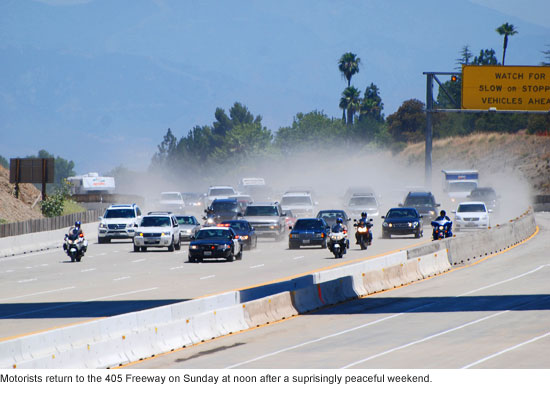 My apologies to New Orleans, but last weekend it was Los Angeles that deserved the nickname “The Big Easy.”
My apologies to New Orleans, but last weekend it was Los Angeles that deserved the nickname “The Big Easy.”
Did you feel it, that strange but satisfying calmness that descended on our roads and neighborhoods, that sense of collective purpose? The closure of the 405 Freeway could have been the mother of all traffic nightmares. Instead, it became a moment to savor—and ponder.
Not since the 1984 Olympics, nearly three decades ago, have our freeways been so blessedly empty. You responded overwhelmingly to our warnings (Carmageddon anyone?) with such incredible results that we now find ourselves in a wholly unexpected discussion. That is: short of jack-hammering a freeway, would it actually be possible to shutdown traffic more regularly, like other countries, to reconnect to a simpler, easier life?
There’s certainly a pent-up craving for it. Look at the overnight popularity of the CicLAvia events. Thousands upon thousands of pedestrians and cyclists of all ages, sizes and colors have flocked to the seven-mile route that snakes through city streets between Hollywood and the Eastside. Created more than 30 years ago in Bogota, Colombia, there have been just two here so far. But another is scheduled for October, and I suspect the turnout will be even larger.
Short of big events or road closures, maybe we could start modestly by simply choosing to spend more weekends closer to home with family and friends, as so many of you did on Saturday and Sunday. One of my staff members told me that for her and her 2-year-old daughter, a simple stroll around the block led them to a lively gathering of neighbors at an open house. Some of those folks she met for the first time—the start of new friendships.
Of course, there are other ways to tame our traffic and preserve our nerves. Why not explore the region by using public transportation? Wherever you want to go, Metro’s online trip planner will get you there. I know you’ve probably heard this suggestion before. But maybe now, in the afterglow of last weekend, is a good time to experiment.
For me, the truth is that I have more questions than answers about how we can decompress a region so packed with stress. But this I do know: we should not let last weekend simply fade away into L.A. traffic lore. These are the kinds of shared moments that can trigger change. Let’s keep the discussion going. Drop me a note with your thoughts at [email protected] and I’ll write about them in the weeks ahead.
Posted 7/20/11
Carmageddon or Carmaheaven?
July 20, 2011

Last weekend’s closure of the 405 Freeway represented a historic moment in our region’s long traffic history. Bracing—and preparing—for the worst, we were rewarded with a day of surprisingly smooth driving and lower stress. Here’s a video we made to document this important event as we look ahead to doing it all over again eleven months from now.
Posted 7/19/11
Carmageddon by the numbers
July 19, 2011
So how big an impact did the 405 closure have on Los Angeles last weekend? Big, if you believe the statistics that have been trickling in this week. Some numbers—such as the sales tax receipts that will reflect the closure’s economic impact—won’t be available for a while yet. But it’s not too soon to begin a preliminary tally.
- Planned length of the closure: 53 hours. The actual length: 35 hours, 57 minutes on the southbound 405; 35 hours, 58 minutes on the northbound side.
- Amount of money Kiewit Infrastructure West could have been fined for finishing late on the demolition: $72,000 per hour. The bonus Kiewit got for finishing early: $300,000. Savings to the public in salary costs for the early finish (bonus included): $400,000.
- Approximate percentage of normal traffic Caltrans engineers expected would be diverted from the open stretches of the 405 during the closure: 20%. Actual amount: 64-65%.
- The number of vehicles on the northbound 405 at Culver on July 9, the Saturday before Carmageddon: 131,516. The number of vehicles on the northbound 405 at that same location on Carmageddon Saturday: 45,483.
- Estimated ridership increase on free Metro buses and subways: 15-20%.
- Travel time on the 101 Freeway from Laurel Canyon to Downtown L.A. on the Saturday before before the closure: 25 minutes. On Carmageddon Saturday: 12 minutes.
- Number of violent crimes reported to the Los Angeles County Sheriff’s Department and LAPD on Saturday, July 9: 276. On Carmageddon Saturday: 260.
- Number of traffic collisions handled by CHP countywide on July 9: 185. On Carmageddon Saturday: 136.
- Number of people arrested by CHP on Saturday for trying to walk or bicycle on the closed area of the 405: 8.
- Emergency room visits at Ronald Reagan UCLA Medical Center on Carmageddon Saturday: 94. Average daily number of emergency room visits at Ronald Reagan UCLA Medical Center: 121.
- Emergency room visits at Cedars-Sinai Medical Center on Carmageddon Saturday: 199. Average daily emergency room visits at Cedars-Sinai: 228.
- Number of 911 Fire/EMS calls to Los Angeles County and City Fire departments on July 9, the Saturday before Carmageddon: 2,037. Number of 911 Fire/EMS calls to Los Angeles County and City Fire departments on Carmageddon Saturday: 1,773.
- Ozone peak in Los Angeles County on Saturday, July 9, in parts per billion: 91. On Carmageddon Saturday 87.
- Attendance at Los Angeles County beaches on Saturday, July 9: 922,950. On Carmageddon Saturday: 544,850.
- Combined parking revenues from Will Rogers and Zuma beaches for the weekend before the 405 closure: $82,499. On Carmageddon weekend: $36,425—a drop of 55.8%.
- Expected turnout at the July 16 LA Galaxy-Real Madrid soccer game at the Los Angeles Memorial Coliseum: 60,000-100,000. Actual attendance: 56,211. Attendance at last year’s August match at the Rose Bowl between the same teams: 89,134.
- Some good news: Natural History Museum of Los Angeles County attendance on the Saturday before Carmageddon was 1,200. Attendance for the new Dinosaur Hall opening on Carmageddon Saturday: 3,785.
- Google search ranking for the term “Carmageddon” on July 15, the day before the closure: 3. Google search ranking on the same day for “Harry Potter reviews”: 5.
Sources: Los Angeles County Metropolitan Transportation Authority; Caltrans; Los Angeles County Sheriff’s Department; California Highway Patrol; Los Angeles County Dept. of Health Services Emergency Services Agency; South Coast Air Quality Management District; Los Angeles County Fire Department, Lifeguard Division; Los Angeles County Department of Beaches and Harbors; Los Angeles Coliseum; Will Rogers State Park; Natural History Museum of Los Angeles County; Los Angeles County Museum of Art; Google Trends
A speedy recovery on the 405
July 16, 2011
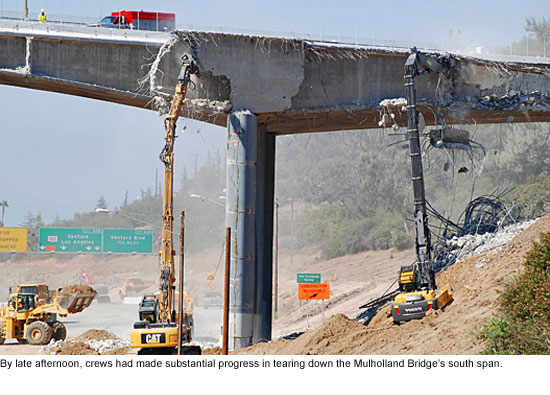 I’ve just spent the better part of this afternoon at the demolition site of the Mulholland Drive bridge over the 405 Freeway. I’m pleased to report (and I’m sure you’ll be pleased to know) that the work is ahead of schedule. The contractor, Kiewitt Co., has been doing a superb job. Its crews moved in last night, shortly after the freeway was closed, and began the demolition of the southern half of the bridge. Before sunset late this afternoon, the flanks of that part of the historic span were almost gone.
I’ve just spent the better part of this afternoon at the demolition site of the Mulholland Drive bridge over the 405 Freeway. I’m pleased to report (and I’m sure you’ll be pleased to know) that the work is ahead of schedule. The contractor, Kiewitt Co., has been doing a superb job. Its crews moved in last night, shortly after the freeway was closed, and began the demolition of the southern half of the bridge. Before sunset late this afternoon, the flanks of that part of the historic span were almost gone.
The consensus is that the contractor will beat by a considerable amount of time the 5:00 a.m. Monday deadline for the freeway’s reopening. Things can still go wrong; this is a complicated and difficult job. But the pace is promising. We’ll know more tonight or tomorrow morning.
Thanks again to all Southern California motorists who stepped up in the last 24 hours to make this freeway closure a far different kind of event than many of us had feared. Earlier today, as I viewed the region’s free-flowing traffic from a helicopter, I was awestruck by the clear evidence of the public’s vast cooperation. And for that little piece of “Carma-heaven” on our roads, we can all take pride.
Remember that we need to sustain this effort for just 24 to 36 more hours, until the job is done. Stay tuned to the news or to my website for the latest information on the progress of this project.
Posted 7/16/11
Could this be Carma-heaven?
July 16, 2011
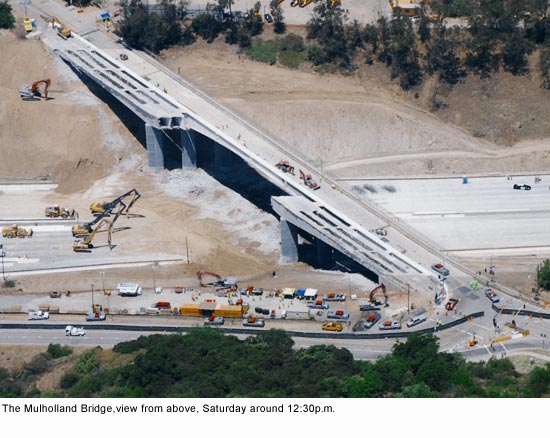 Thank you, Los Angeles, for successfully taking on Carmageddon. You stepped up yesterday evening and this morning. Southern California motorists followed the advice of public officials and traffic experts and are staying out of their cars. That is the only reason why traffic in our region was at all-time lows for a Friday evening.
Thank you, Los Angeles, for successfully taking on Carmageddon. You stepped up yesterday evening and this morning. Southern California motorists followed the advice of public officials and traffic experts and are staying out of their cars. That is the only reason why traffic in our region was at all-time lows for a Friday evening.
I was at the 405 and Mulholland Drive last night at midnight to witness the closing of the freeway and the beginning of the bridge removal project that has caused all of this fuss. It was an eerie feeling to see the cars thinning out on the freeway as the closing approached, but it was also heartening that this region came together in common cause to help manage what otherwise could have been a traffic nightmare.
As I told a reporter last night, most of us feel that if we don’t get in our car on a weekend and go somewhere, then somehow we’re being cheated. In fact, what L.A. is finding out this weekend is that there’s a lot to do and see within walking distance of our own homes.
We have 40 hours or less to go, and I urge all of you to stay the course. Stay home, patronize local stores and restaurants, and do everything you can to stay out of your cars until this weekend’s work is completed. It worked last night, and it’s working this morning. We need to sustain this for another day and a half, and then Carmageddon will be in our rear view mirror.
Posted 7/16/11
Zev discusses the 405 freeway closure
July 15, 2011

Zev discusses the July 16-17, 2011 405 Freeway closure.
This video was produced by the Jewish Journal.
Here we go
July 14, 2011
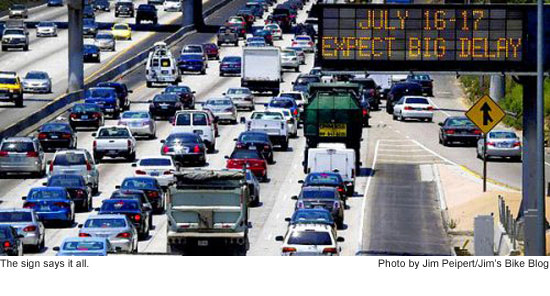 Yes, it’s finally here, “Carmageddon” weekend.
Yes, it’s finally here, “Carmageddon” weekend.
I feel confident that, by now, you know what I’m talking about. And that’s a testament to the extraordinary outreach efforts of our state and local transportation officials. Now, it’s up to us to help make sure that the 53-hour closure of the 405 Freeway isn’t any worse than it absolutely must be.
Of course, the best thing we can do is stay out of our cars for a couple days. But if you must hit the road, then please check the traffic reports and stay cool. There’s no need to see red (except for brake lights) if you leave early and are prepared for the frustrations of traffic. We’ve pulled together some basic information to help you on your way, which you’ll find here as part of our 405 Report. And if you’re looking for things to do—maybe 53 of them—check this out.
Meanwhile, I hope you’ll visit my website throughout the weekend. I’ll be blogging live, giving you my view of the unfolding events. I encourage you to upload photos of what you see out there to a special “Carmageddon” album we’ve created on the website’s “Picture This” feature.
I’ll also be posting updates on my Twitter and Facebook pages, so please drop by. No doubt, this will be a memorable weekend in L.A.’s traffic history. Let’s do our best—together—to make those memories good ones. Thanks for reading and, as always, you can reach me at [email protected].
Posted 7/14/11
Metro’s orange brigade hits the rails
July 13, 2011
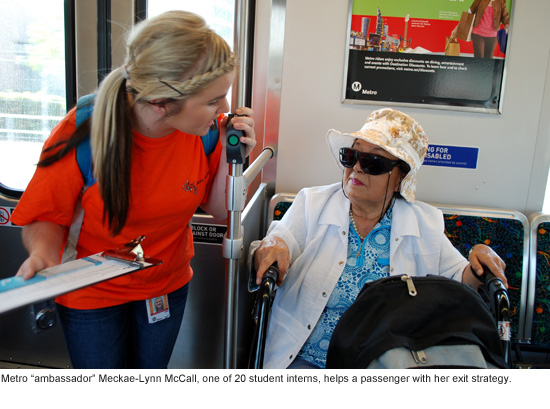 Meet Meckae-Lynn McCall, train ambassador.
Meet Meckae-Lynn McCall, train ambassador.
Although she’s just 20, and her ambassadorial appointment only lasts as long as her summer internship, she’s already got some diplomatic moves down.
There she was on an eastbound Gold Line train Thursday morning, brightly smiling as she complimented a bicyclist for stashing her ride in the correct area, and gently counseling an elderly traveler about where to exit (“The next station you’re going to want to get off…You’re very welcome, ma’am.”)
McCall is part of a new Metro summer program in which teams of student interns are jumping aboard trains and approaching customers at stations to spread the word that bikes—as well as wheelchairs, suitcases and other large items—now have a designated place on Metro trains.
Enforcers they’re not. Rather, the train ambassadors’ role is to “catch people being good,” said Alice Tolar, a Metro transportation planning manager who is overseeing the program.
“If I see you standing with your bike in the appropriate area, I’m going to thank you for that…We’re also letting non-cyclists hear what’s going on,” she said.
In addition to reinforcing good behavior, the interns will be handing out brochures detailing the agency’s current bike policy: big yellow decals now mark designated spaces on trains for bikes and other large items, and train cars are being reconfigured to create more space for bikes. (Only the Red Line cars are finished so far; reconfiguring the rest will take up to 18 months.)
The intern outreach program and the train car reconfiguration are elements of a broader effort by Metro to boost ridership by increasing its bicycle-friendliness. As part of those efforts, the agency has convened a Bicycle Roundtable and sponsored recently-released studies on how cyclists are using Metro Rail and the Orange Line. (A brief summary is here.)
The new student interns—20 of them in all—will start riding the rails officially on Monday, July 11. (Look for them first at the North Hollywood and Universal Red Line stations; they’ll be the ones in the bright orange T-shirts.) Meanwhile, they’ve divided up into teams: The Invincibles, The Phixies, Team Amazing and Team Enrique.
On Wednesday morning, they took part in some enthusiastic role-playing to get the feel of their various jobs, which in addition to train ambassador include platform ambassador, platform greeter and data collector.
With some help from the program leaders, the interns created and responded to characters ranging from an insistent smoker to a rider transporting unwieldy loads of flowers.
James Reed, who played the smoker as a blind man wielding a cardboard box as a cane, drew laughs in his mock showdown with another intern, Robert Jong. “Why can’t I smoke in the train? I’m handicapped!” he said, as Jong desperately cajoled, “Sir, there’s no smoking…”
(Afterward, they agreed that the interns shouldn’t try to confront people they see misbehaving but should notify security if it seems warranted.)
They also brainstormed ice-breakers for approaching customers, including “Nice bike!” or “We’ve made room for you” or the ever-popular, “Thank you for riding Metro!” The student interns are being paid from $8 to $12 an hour, depending on where they are in their education, from high school to grad school.
Their goal is “52 stations in 20 days”—not exactly “Around the World in 80 Days,” but definitely more do-able.
For some of the students, the internship is good experience for a future career in urban planning or transportation. For others, it’s a way to start—or expand—a professional resume. Either way, it’s a paying summer job, and a chance to encounter an unmatched array of people and situations on Metro trains.
One of the train ambassadors, Fayma Ishaq, a grad student at Cal Poly Pomona, struck up a conversation with lifelong transit rider Albert Herrera aboard the Gold Line Thursday. He told her he’d once seen a baby knocked to the ground by an impatient exiting passenger. “It’s good we’re making space because we don’t want incidents like this to happen,” Ishaq told Herrera.
Elsewhere on the train, Meckae-Lynn McCall, an early education major at Harding University, got a chance to hand out one of the first brochures to cyclist Marissa Siaz, a freelance cake decorator who also works in a Pasadena school supply store and a South Pasadena pizza place.
Siaz, 21, said she generally feels comfortable taking her bike onboard the train. “I feel welcome as long as I put it where it’s supposed to go,” she said. As for the new, intern-powered outreach campaign? Couldn’t hurt, she said. “I think most people already know [how and where to put their bike] and they just don’t want to do it. Some people don’t want to leave it there.”
Photos by Supervisor Yaroslavsky’s web staff
Posted 7/8/11




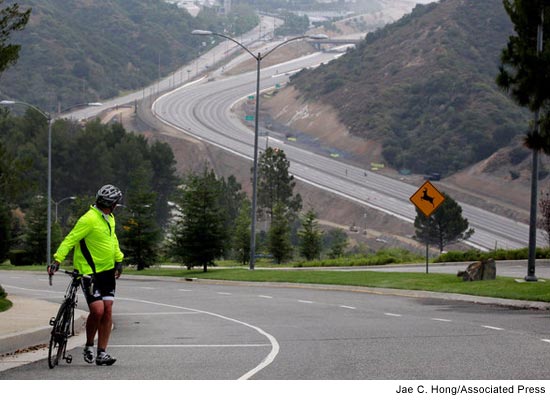
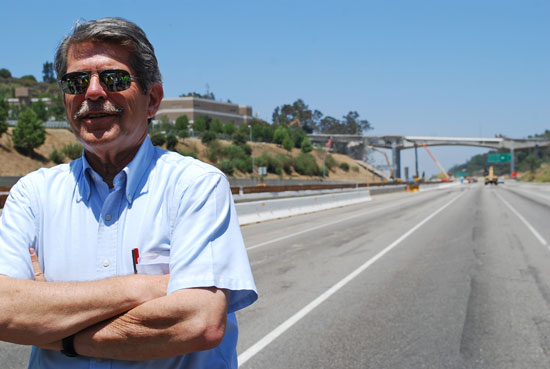
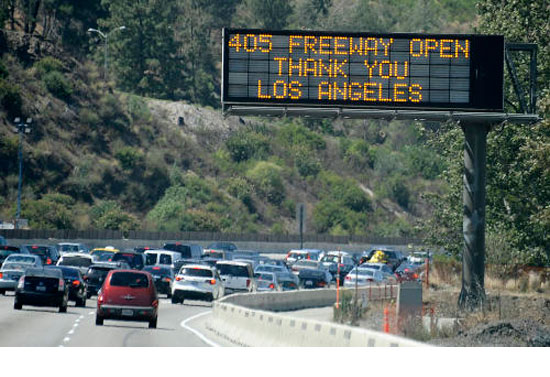


























 Check for the latest closure information
Check for the latest closure information








